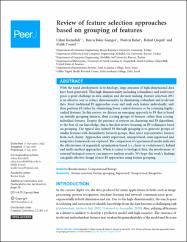| dc.contributor.author | Kuzudisli, Cihan | |
| dc.contributor.author | Bakir-Gungor, Burcu | |
| dc.contributor.author | Bulut, Nurten | |
| dc.contributor.author | Qaqish, Bahjat | |
| dc.contributor.author | Yousef, Malik | |
| dc.date.accessioned | 2024-04-16T07:21:46Z | |
| dc.date.available | 2024-04-16T07:21:46Z | |
| dc.date.issued | 2023 | en_US |
| dc.identifier.issn | 2167-8359 | |
| dc.identifier.uri | https://doi.org/10.7717/peerj.15666 | |
| dc.identifier.uri | https://hdl.handle.net/20.500.12573/2096 | |
| dc.description.abstract | With the rapid development in technology, large amounts of high-dimensional data have been generated. This high dimensionality including redundancy and irrelevancy poses a great challenge in data analysis and decision making. Feature selection (FS) is an effective way to reduce dimensionality by eliminating redundant and irrelevant data. Most traditional FS approaches score and rank each feature individually; and then perform FS either by eliminating lower ranked features or by retaining highly-ranked features. In this review, we discuss an emerging approach to FS that is based on initially grouping features, then scoring groups of features rather than scoring individual features. Despite the presence of reviews on clustering and FS algorithms, to the best of our knowledge, this is the first review focusing on FS techniques based on grouping. The typical idea behind FS through grouping is to generate groups of similar features with dissimilarity between groups, then select representative features from each cluster. Approaches under supervised, unsupervised, semi supervised and integrative frameworks are explored. The comparison of experimental results indicates the effectiveness of sequential, optimization-based (i.e., fuzzy or evolutionary), hybrid and multi-method approaches. When it comes to biological data, the involvement of external biological sources can improve analysis results. We hope this work’s findings can guide effective design of new FS approaches using feature grouping. | en_US |
| dc.description.sponsorship | This work has been supported by the Zefat Academic College. Burcu Bakir-Gungor’s work has been supported by the Abdullah Gul University Support Foundation (AGUV). The funders had no role in study design, data collection and analysis, decision to publish, or preparation of the manuscript. | en_US |
| dc.language.iso | eng | en_US |
| dc.publisher | PeerJ Inc. | en_US |
| dc.relation.isversionof | 10.7717/peerj.15666 | en_US |
| dc.rights | info:eu-repo/semantics/openAccess | en_US |
| dc.subject | Feature selection | en_US |
| dc.subject | Integrative | en_US |
| dc.subject | Supervised | en_US |
| dc.subject | Unsupervised | en_US |
| dc.subject | Feature grouping | en_US |
| dc.title | Review of feature selection approaches based on grouping of features | en_US |
| dc.type | article | en_US |
| dc.contributor.department | AGÜ, Mühendislik Fakültesi, Bilgisayar Mühendisliği Bölümü | en_US |
| dc.contributor.authorID | 0000-0002-2272-6270 | en_US |
| dc.contributor.authorID | 0000-0002-1895-8749 | en_US |
| dc.contributor.institutionauthor | Bakir-Gungor, Burcu | |
| dc.contributor.institutionauthor | Bulut, Nurten | |
| dc.identifier.volume | 11 | en_US |
| dc.identifier.startpage | 1 | en_US |
| dc.identifier.endpage | 37 | en_US |
| dc.relation.journal | PeerJ | en_US |
| dc.relation.publicationcategory | Makale - Uluslararası Hakemli Dergi - Kurum Öğretim Elemanı | en_US |


















